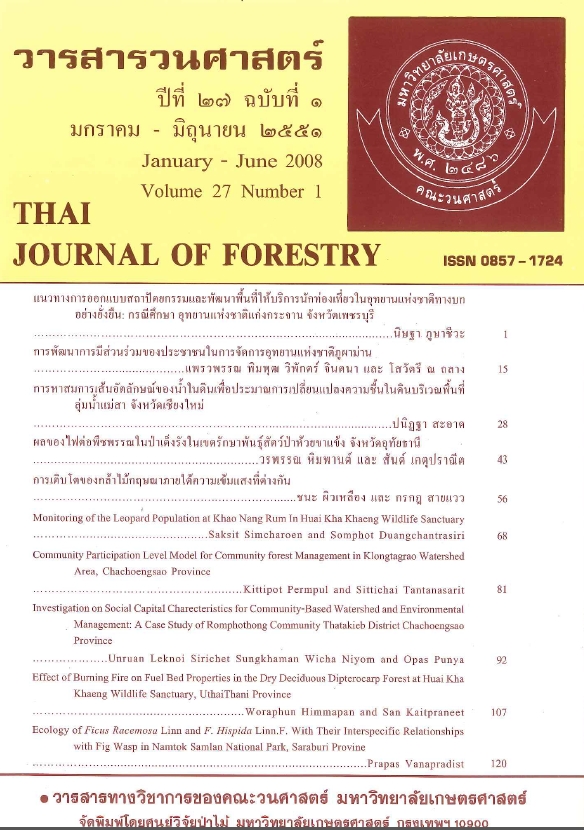Ecology of Ficus racemosa Linn. and F. hispida Linn. With Their Interspecific Relationships with Fig Wasp in Namtok Samlan National Park, Saraburi Provine
Main Article Content
บทคัดย่อ
The purposes of this research were determine to the ecological distribution of figs along the altitudinal gradient; phenology of two fig species, namely Ficus. racemosa Linn. and F. hispida Linn; and interspecific relationships of fig and fig wasp mutualism. The research was carried out in two selected forest types, namely mixed deciduous forest (MDF) and dry evergreen forest (DEF) at Namtok Samlan National Park (NSNP) in Saraburi Province. It was conducted during January 2005 to January 2006. This study site covers the altitude from 100 to 300 meters above mean sea level. Quadrats were used for collecting and identifying the vegetation and the data were quantitatively analyzed. The results showed that 83 species in 62 genera and 31 families were found. The top ten important value index (IVI)species were Lagerstroemi calyculata Kurz (24.13%), Colona sp. (21.00%), Bombax anceps Pierre. (15.96%), Leucaena leucocephala de Wit.(12.80%) Vitex peduncularis Pirerre. (10.44%), Dialium cochinchinense Pierre (8.41%), Hymenodictylon excelsum (Roxb) Wall (7.82%), Parinari anamense Hance (6.81%), Adinanthera pavovina Linn (6.69%) and Memecylon sp.(6.56%), including F.hispida L. (4.52%) and F. racemosa L. (3.63%) respectively. The plant communities at MDF could be classified into two groups, in both MDF and DEF. The amount of plant species and all individual species demonstrated inclination to decrease with increasing of elevations. The distribution patterns of both fig species were clumped and the fruiting periods were found all through the year. It can be seen that leaf production in F.racemosa L was, although present. The presence of fruit on the trees was in contrast very even throughout the year. The interspecific relationships of fig and fig wasp in monoecious figs (F. racemosa L.) and dioecious figs (F. hispida L.) observed, The number of fig species and their density decreased with increasing elevation. The existing fig wasp of F. racemosa L. and F. hispida L. were Ceratosolen fusciceps Mayr and Ceratosolen solmsi marchali Mayr respectively. The data can be applied to build up the new figs communities and to manage food plants for wildlife.
Keywords: Ecological distribution, Phenology, Interspecific relationships, Fig wasp
Downloads
Article Details

อนุญาตภายใต้เงื่อนไข Creative Commons Attribution-NonCommercial-NoDerivatives 4.0 International License.
ข้าพเจ้าและผู้เขียนร่วม (ถ้ามี) ขอรับรองว่า ต้นฉบับที่เสนอมานี้ยังไม่เคยได้รับการตีพิมพ์และไม่ได้อยู่ในระหว่างกระบวนการพิจารณาตีพิมพ์ลงในวารสารหรือสิ่งตีพิมพ์อื่นใด ข้าพเจ้าและผู้เขียนร่วม (ถ้ามี) ยอมรับหลักเกณฑ์และเงื่อนไขการพิจารณาต้นฉบับ ทั้งยินยอมให้กองบรรณาธิการมีสิทธิ์พิจารณาและตรวจแก้ต้นฉบับได้ตามที่เห็นสมควร พร้อมนี้ขอมอบลิขสิทธิ์ผลงานที่ได้รับการตีพิมพ์ให้แก่วารสารวนศาสตร์ คณะวนศาสตร์ มหาวิทยาลัยเกษตรศาสตร์ กรณีมีการฟ้องร้องเรื่องการละเมิดลิขสิทธิ์เกี่ยวกับภาพ กราฟ ข้อความส่วนใดส่วนหนึ่ง หรือ ข้อคิดเห็นที่ปรากฏในผลงาน ให้เป็นความรับผิดชอบของข้าพเจ้าและผู้เขียนร่วม (ถ้ามี) แต่เพียงฝ่ายเดียว และหากข้าพเจ้าและผู้เขียนร่วม (ถ้ามี) ประสงค์ถอนบทความในระหว่างกระบวนการพิจารณาของทางวารสาร ข้าพเจ้าและผู้เขียนร่วม (ถ้ามี) ยินดีรับผิดชอบค่าใช้จ่ายทั้งหมดที่เกิดขึ้นในกระบวนการพิจารณาบทความนั้น”


